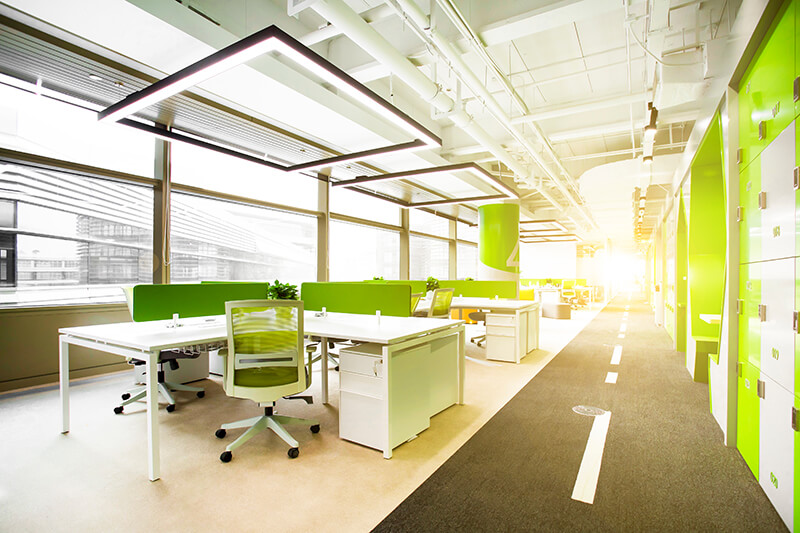Due to the pandemic, going to your workplace in the last couple of years might have been difficult. COVID-19 certainly changed the way office spaces are being designed moving forward.
And, because every new year comes with new challenges and opportunities, CommercialCafe wondered what 2023 had in store for the commercial interior design sector. So, we spoke with several interior designers to learn their insights on the office interior design trends for 2023; what worked in the past and what didn’t; “resimmercial” design; and more. Read on to find out what they had to say.
Meet our Experts

Margine Biswas
AIA, NCARB, LEED AP, Interior Designer at Archiphy

George J. Kimmerle, PhD
AIA, PP, NCARB, President at Kimmerle Group

Adrienne Nelson
AIA, IIDA, Principal at Pickard Chilton

Tressya Minndizz
Interior Designer at Ark Interiors

Janna Robinson
Interior Designer at Janna Robinson
What is your approach to commercial interior design?
Margine Biswas
“After gaining an understanding of the client’s program, we create a range of options for discussion with the client. For each option, we explain and illustrate it in both words and images. The precise design of a commercial interior is dependent upon the nature of the use and the occupant.”
George J. Kimmerle
“We are designers and architects professionally engaged in these issues, which have evolved over the five-plus decades of our professional lives. We have been dealing with workplace impacts and changes that first included and originated from changing corporate structures to vast technology changes and to the more recent impacts of remote work and the merging of work and lifestyle.”
Tressya Minndizz
“Understand the space: Before starting the design process, take the time to understand the space you will be working with, including its dimensions, layout and natural light sources.
- Define the purpose of the space: Determine the primary function of the space and design it to support that purpose. This includes considering factors such as traffic flow, functionality and ergonomics.
- Create a mood or atmosphere: Use color, lighting, and materials to create a specific mood or atmosphere in the space. This can help create an emotional connection with customers and improve the overall experience.
- Consider the brand identity: Incorporate the company’s branding and design elements into the space to create a cohesive look and feel.
- Use lighting effectively: Lighting is a powerful tool in interior design and can be used to create different moods and highlight specific areas.
- Incorporate sustainable design principles: Consider using sustainable materials and incorporating energy-efficient lighting and HVAC systems to reduce the environmental impact of the space.
- Be flexible and adaptable: With consideration of the space’s purpose, it’s important to design an interior that can adapt to changing needs and technologies.
- Add personal touches: Personal touches — such as artwork, plants and unique design elements — can help create a unique and inviting atmosphere.”
Adrienne Nelson
“Fundamentally, we humanize the workplace. Our studio is focused on creating an inviting spatial experience that allows people to meet their full potential.”
Janna Robinson
“Mindfulness: Listening [and] understanding the goals and needs of the client to create functional and visually appealing spaces.
- Thoughtfulness: Keeping the space safe (code-compliant), healthy and functional.
- Functionality: It is critical to understand the flow of the space; the layout; and conduct proper space planning, which is paramount to the overall efficiency of the space.
- Creative design: Being innovative and providing a timeless design, while incorporating fun and trendy accents.
- Balance: Designing a well-balanced space that has the desired aesthetics, comfort, warmth, form and functionality.”
How do you think that the pandemic and working from home affected commercial interior design?
Margine Biswas
“The pandemic has created a more fragmented environment in terms of interactions in the workplace with increased distance and limitations to social contact.”
George J. Kimmerle
“In the first instance, the drive to merge and find flexibility and a shared and balanced life/work schedule is yet another wrinkle in the evolution of the workplace. We have embraced these approaches for decades. And, we applaud this latest trend and, frankly, think it is long overdue. Yet, our work has also embraced much of this over the past in both the corporate and educational areas. Collaborative work and teaching spaces; group and team benching environments; and a long list of breakout, lounge, and meditation spaces that include interior environments, outdoor and rooftop lounges, and play spaces, to mention a few.”
Tressya Minndizz
“The COVID-19 pandemic and the widespread adoption of remote work have had a significant impact on commercial interior design. Some of the ways this has affected the field include:
- Increased emphasis on health and safety: The pandemic has made it clear that the health and safety of employees and customers is of the utmost importance. This has led to a greater focus on designing spaces that promote cleanliness and reduce the spread of germs, such as by incorporating touchless technologies; incorporating more natural light and plants; and designing for better ventilation.
- Changes in office layout: With many employees working remotely, there has been a shift away from traditional, open-plan offices and a move toward more flexible, hybrid work environments. This includes more emphasis on creating private spaces for focused work, as well as incorporating technology that allows for virtual meetings and collaboration.
- Prioritizing mental health: The pandemic has led to an increased awareness of the importance of mental health, and commercial interior designers are now considering how to design spaces that promote well-being, such as by incorporating natural elements, providing access to green spaces, and creating a sense of connection.
- Emphasis on technology: With remote work becoming the norm, commercial interior designers are now placing more emphasis on incorporating technology that facilitates virtual meetings and collaboration. This includes designing spaces with ample power and data points and incorporating smart building technology to optimize energy efficiency.
- Remote working areas: With remote working becoming more prevalent, commercial interior designers are now designing areas specifically for remote working. This includes spaces that promote productivity, relaxation and comfort.
Overall, the pandemic and work from home have led to a greater emphasis on designing spaces that prioritize health and safety; flexibility; and technology and promote well-being for employees and customers.”
Adrienne Nelson
“The blend of remote and in-person work has increased the need for greater flexibility, collaborative spaces and access to the outdoors. The bar is much higher than before.
Currently, most people work between two offices — their home and their workplace — while some of us also work on the road, in hotels, airports and cafes.
When we enter the office, it needs to provide the same essentials that can be provided at home or on the road, but also offers quiet areas for focused work and access to natural light and fresh air. The space needs to also create opportunities for meaningful collaboration at various scales. And, in a world where you can work anywhere, the space needs to inspire people to want to stay.”
Janna Robinson
“It has shifted the paradigm where business owners and employees alike have had to adapt and evolve. It is encouraging business owners to create more of a ‘Resimmercial’-type [of] ecosystem.”
What are some of 2022’s commercial interior design trends that you would like to see more of in 2023?
Margine Biswas
“Restaurants should incorporate convenient curb pick-up features, such as AI-driven technology, while offices should emphasize a feeling of privacy within their space.”
Adrienne Nelson
“Locally sourced materials, inspiration from nature [and] integration of technology.”
Janna Robinson
“Textured materials and finishes. Comfortable furnishings — softer, warmer and cozier special touches, which we aren’t accustomed to seeing in a commercial space. Like decorative throw pillows, accent rugs, poufs, drapery, biophilia, wallpaper and fun accessories, which immediately evoke a sense of comfort, joy, and by and large, a more productive and positive work environment. [Also,], leisure spaces, outdoor spaces [and] natural lighting.”
Which office interior design trends do you think will have the most success this year?
Margine Biswas
“To create a feeling of contentment, office interiors should offer larger, more open spaces and facilitate access to the outdoors.”
Tressya Minndizz
“Some office interior design trends that are likely to have success this year include:
- Biophilic design: Incorporating natural elements — such as plants, natural light and natural materials — into the office environment is becoming increasingly popular. This is because studies have shown that biophilic design can promote employee well-being, productivity and creativity.
- Flexible workspaces: The shift to remote work has led to a greater emphasis on creating flexible workspaces that can adapt to different workstyles and tasks. This includes incorporating a variety of different types of spaces, such as private phone booths, standing desks and quiet zones.
- Sustainable design: With concerns about environmental sustainability and climate change on the rise, sustainable design is becoming increasingly important. This includes using materials that are environmentally friendly; incorporating energy-efficient lighting and HVAC systems; and designing spaces that promote natural ventilation.
- Wellness features: As the pandemic has brought attention to the importance of mental and physical health, more office designs incorporate features that promote wellness, such as natural light, access to green spaces, and areas for relaxation and meditation.
- Technology integration: With the increasing use of technology in the workplace, designers are now incorporating technology into office spaces, such as charging ports, high-speed internet and video conferencing capabilities.
- Colorful and fun spaces: As the world starts to get back to normal, the trend of creating colorful and fun spaces that inspire creativity and positivity is likely to increase, with more use of bright colors, patterns and playful elements in office design.
It’s worth noting that these are general trends, and each company might have different needs and preferences. Also, the trends mentioned here might not be suitable for all types of businesses.”
Adrienne Nelson
“I believe locally sourced materials will play an increasingly important role. As we are focused on health more than ever before, many of us are increasingly aware of the impact of our carbon footprint. When we specify locally sourced materials, not only does it help the environment, but it also creates a meaningful connection to the community and its economy.”
Janna Robinson
“Collaborative spaces: I believe cubicles and other means of creating separation will be in the rearview mirror and the emphasis will be on creating more collaborative spaces with a fusion of homier interior design elements.
- Pops of color and prints: While naturalism is on the rise, offices are ready to express themselves and infuse some personality. The land of neutral certainly has its place, but more business owners are embracing elements of boldness.
- Wellness: Special air purifiers, water filtration systems, lighting systems designed to mimic our own circadian rhythm [and] rooms for relaxation.
- Biophilia and living walls: Studies have shown that the life force and vibrancy of plants not only improve air quality in a room, but [also] can reduce blood pressure; relieve stress [and] anxiety; and help with the overall wellbeing and mental acuity.
- Organic, natural and sustainable materials, like wood, stone, natural fabrics, copper and brass.
- Sound absorption solutions: Decorative acoustic panels for walls and ceilings.”
What commercial design trends do you expect to decline in 2023?
Margine Biswas
“By bringing employees back to the workplace, organizations will reduce the amount of space for each employee, thereby restoring a more traditional work environment. Moreover, workers will have fewer opportunities to telecommute, eliminating a lot of the flexibility they’ve grown accustomed to.”
Adrienne Nelson
“I expect that we’ll see the waning of large, stepped seating elements in public spaces. The original success of these elements was their ability to activate large public spaces and lobbies, but it has become diluted over time. What was once a brilliant tool to create a multifunctional space has become empty and less successful when used in a private office environment.”
Janna Robinson
“Pods and/or fixed spaces: Even though they create small, private spaces (which have their relevance), I feel offices are promoting unity, collaboration and focusing more on human connection. [Also,] the land of neutral [and] soulless, cold, and sterile interiors and materials.”
What trends — in terms of colors, textures and patterns — should businesses be aware of in the upcoming year?
Margine Biswas
“Nature-inspired colors are expected to be a key trend in 2023, providing an evocative reminder of the outdoors and the comfort of home.”
Adrienne Nelson
“Again, reflecting people’s desire to connect with nature, I suspect we will see more colors and textures directly informed by nature.”
Janna Robinson
“Mixed materials; stones with wood; performance-textured and plush fabrics — like boucle, mohairs (real and fake) — that evoke the senses of touch; quality-textured faux leathers; natural fabrics, like Jute; copper adding a more natural and authentic look to the space.”
In your opinion, will combining old and new still be popular in 2023?
Margine Biswas
“Yes, utilizing existing and modern materials can provide an efficient and sustainable means of repurposing.”
Adrienne Nelson
“There is always room to incorporate timeless and classic pieces. They often bring a sculptural quality that can easily define a space and create reverence.”
Janna Robinson
“While more modern and streamlined design is leading the charge in 2023 with warmth and elegance, there is always inspiration from past trends and styles to embrace and draw upon.”
What are your thoughts on “resimmercial” furnishings?
Margine Biswas
“Resimmercial is a beneficial method of acclimating employees who have grown accustomed to working from home back into the traditional office environment.”
Adrienne Nelson
“Creating a warm, rich, hospitality feel within the workplace is, we believe, the best way to elevate and enhance the everyday experience. The ability to step away from a traditional desk and immediately change your environment shifts your mindset — even if it is only a few feet away. Collaborating with colleagues around a coffee table is a different experience than at a formal conference table.”
Janna Robinson
“Resimmercial’ is one of the biggest trends for 2023 and potentially for the foreseeable future. There is nothing better than the creature comforts of home, so company owners are infusing a more relaxed and sophisticated environment where people feel comfortable, at ease, productive and inspired.
Plush and curvier silhouettes of furniture; area rugs; throw pillows and blankets; fun accessories; artwork; [and] biophilia.”
Are there any other insights that you would like to share with us?
George J. Kimmerle
“We are approaching it all from the personal side as artists and designers deeply dependent on a style and pattern of work, which immensely benefits from a collaborative approach to our design and planning process. The creative arts are intimately linked to collaboration and the sharing of ideas and other forms of conceptual thinking.
So, with respect to our own working dynamics, we are in the midst of an exploration: How can we justify and reconcile the creative process to remote and flexible work schedules, while embracing family and personal needs? A new and complex challenge. We understand the dynamic and are working toward a new vision for how we can all embrace a wider and more inclusive way of interacting in both senses.”
Adrienne Nelson
“We are seeing a stronger effort in the industry to reposition existing structures. As such, designers will need to be more flexible and adept at creating spaces that maximize functionality, while capturing the positive elements within the existing structure.”
Janna Robinson
“Technology: More commercial spaces are integrating and reflecting progressions in technology. Specifically, smart technology, including virtual assistants for automated lighting systems, all different types of sensors, remote-controlled appliances, virtual reality and more.”
For more useful and informative advice, check out our Expert Insights & Roundup Series.



